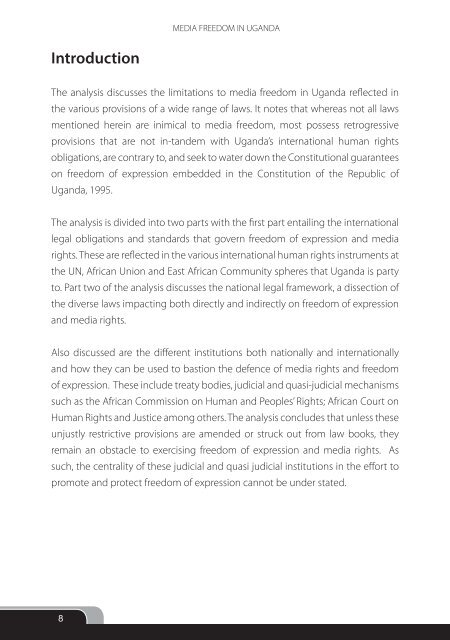Media_Freedom_in_Uganda_Analysis_of_inequitable_legal_limitations
Media_Freedom_in_Uganda_Analysis_of_inequitable_legal_limitations
Media_Freedom_in_Uganda_Analysis_of_inequitable_legal_limitations
Create successful ePaper yourself
Turn your PDF publications into a flip-book with our unique Google optimized e-Paper software.
MEDIA FREEDOM IN UGANDA<br />
Introduction<br />
The analysis discusses the <strong>limitations</strong> to media freedom <strong>in</strong> <strong>Uganda</strong> reflected <strong>in</strong><br />
the various provisions <strong>of</strong> a wide range <strong>of</strong> laws. It notes that whereas not all laws<br />
mentioned here<strong>in</strong> are <strong>in</strong>imical to media freedom, most possess retrogressive<br />
provisions that are not <strong>in</strong>-tandem with <strong>Uganda</strong>’s <strong>in</strong>ternational human rights<br />
obligations, are contrary to, and seek to water down the Constitutional guarantees<br />
on freedom <strong>of</strong> expression embedded <strong>in</strong> the Constitution <strong>of</strong> the Republic <strong>of</strong><br />
<strong>Uganda</strong>, 1995.<br />
The analysis is divided <strong>in</strong>to two parts with the first part entail<strong>in</strong>g the <strong>in</strong>ternational<br />
<strong>legal</strong> obligations and standards that govern freedom <strong>of</strong> expression and media<br />
rights. These are reflected <strong>in</strong> the various <strong>in</strong>ternational human rights <strong>in</strong>struments at<br />
the UN, African Union and East African Community spheres that <strong>Uganda</strong> is party<br />
to. Part two <strong>of</strong> the analysis discusses the national <strong>legal</strong> framework, a dissection <strong>of</strong><br />
the diverse laws impact<strong>in</strong>g both directly and <strong>in</strong>directly on freedom <strong>of</strong> expression<br />
and media rights.<br />
Also discussed are the different <strong>in</strong>stitutions both nationally and <strong>in</strong>ternationally<br />
and how they can be used to bastion the defence <strong>of</strong> media rights and freedom<br />
<strong>of</strong> expression. These <strong>in</strong>clude treaty bodies, judicial and quasi-judicial mechanisms<br />
such as the African Commission on Human and Peoples’ Rights; African Court on<br />
Human Rights and Justice among others. The analysis concludes that unless these<br />
unjustly restrictive provisions are amended or struck out from law books, they<br />
rema<strong>in</strong> an obstacle to exercis<strong>in</strong>g freedom <strong>of</strong> expression and media rights. As<br />
such, the centrality <strong>of</strong> these judicial and quasi judicial <strong>in</strong>stitutions <strong>in</strong> the effort to<br />
promote and protect freedom <strong>of</strong> expression cannot be under stated.<br />
8


